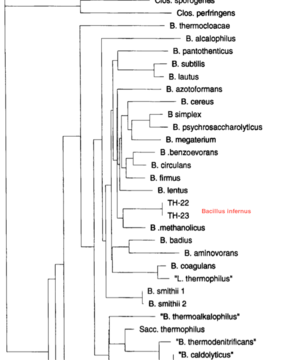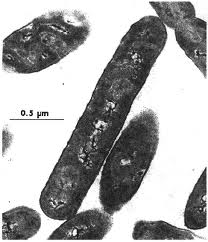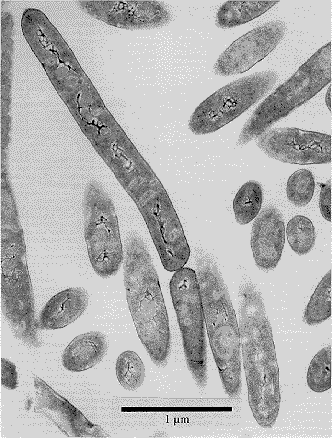Bacillus infernus
Thin-section electron micrograph of Bacillus infernus, sp. nov., isolated from ca. 2.7 km below land surface in the Taylorsville Basin. These new species (Th-22 and TH-23) proposed
by D. R. Boone et. al (1995) are thermophilic, halotolerant, and Fe(III)- and Mn(IV)-reducing anaerobes. Photo from geoweb.princeton.edu
A Microbial Biorealm page on the genus Bacillus infernus

Higher order taxa
Species
Bacillus infernus
Nonmotile rods (including possible yet unconfirmed endospores) inhabiting the deep terrestrial subsurface of the Taylorsville, Virginia Triassic Basin. The organism is thermophilic, halotolerant, and slightly alkaliphilic. B. infernus is important because it can affect geochemical processes including transport of toxic chemicals similar to other subsurface microorganisms. B. infernus also possesses a “novel” metabolism perhaps useful in future bioremediation of the environment, biotechnology, and industry[1].
Genomic information
16S rDNA partial sequencing of two anaerobic strains (Th-22 and TH-23) have been studied via PCR amplification. The isolated portion contains nearly the entire gene; approximately 1500 base segments[1][2]. The study concluded B. infernus should be classified as a new Bacillus species based on RDP database information[1][2][3][4]. In 2002, the SPlB (partial cds) and RecA genes (partial cds) were sequenced[6][7].

Photo from Wikipedia.
Cell and colony structure
These gram-positive cells are non-motile rods. Dimensions are 0.7μm X 0.8μm in width by 4.0μm X 8.0μm in length. Endospores seem possible but as yet undetermined. Colony growth is pinpoint[1].
Metabolism
B. infernus is strictly anaerobic. It's the only strict anaerobe known of the Bacillus genus. Growth is fermentative utilizing glucose or respiratory using formate, lactate, MnO2, Fe3+, trimethylamine oxide, and nitrate as electron donors. Nitrate is reduced to nitrite but not further reduced to ammonia or N2.
- "Metal reduction by thermophilic organisms is of great interest for a number of reasons. First, hydrothermal systems are often considered modern analogs of the ancient Earth’s biosphere, and Fe(III) reduction could have been an important process on early Earth. Second, the study of metal-microbe interaction is relevant when undertaking the search for life on other planets. Magnetite, a product of microbial reduction of iron, may constitute a robust bio-marker that may have survived through later stages of alteration. Third, metal reduction by thermophilic organisms is intimately connected to human life, such as bioremediation of heavy metals and radionuclides in abandoned nuclear facilities and landfill sites"[5].
Ecology
Deep terrestrial subsurface; Known samples obtained from depths of 2.65 to 2.77 km in the Taylorsville Triassic basin, Virginia. Bacillus infernus is thermophilic (61ºC), halotolerant (0.6 M Na+), and very slightly alkaliphilic (pH 7.3 to 7.8) [1]. Parenthesis denote optimal conditions.
References
[1]Boone, D. R., Liu, Y., Zhao, Z., Balkwill, D. L., Drake, G. R., Stevens, T. O., & Aldrich, H. C. (1995). Bacillus infernus sp. nov., an fe(iii)- and mn(iv)-reducing anaerobe from the deep terrestrial subsurface. International journal of systematic bacteriology, 441-448. doi: 10.1099/00207713-45-3-441. http://www.ncbi.nlm.nih.gov/pubmed/8590670
[2]Boone, D. R., Liu, Y., Zhao, Z. J., Balkwill, D. L., Drake, D. R., Stevens, T. O., & Aldrich, H. C. (2009, March 05). Bacillus infernus strain TH-23 16s ribosomal RNA, partial sequence. Retrieved from http://www.ncbi.nlm.nih.gov/nuccore/NR_027227.
[3]Balkwill D.L.,Bacillus infernus TH-22 16s small subunit rRNA gene, partial sequence. (1995, May 18). Retrieved from http://www.ebi.ac.uk/ena/data/view/U20384
[4]Balwill, D. L. (1195, July 9). Bacillus infernus sp. nov., an Fe(III)- and Mn(IV)-reducing anaerobe from the deep terrestrial subsurface. Retrieved from http://rdp.cme.msu.edu/hierarchy/hierarchy_browser.jsp?qvector=65535&depth=0&openNode=0&seqid=¤tRoot=2268&searchStr=bacillus%20infernus&endDataValue=&showOpt=
[5]Dong, H. L., & Yu, B. S. (2007). Geomicrobiological processes in extreme environments: A review. (3rd ed., Vol. 30, pp. 202-216). China: International Union of Geological Sciences. Retrieved from http://home.dgeo.uevora.pt/~pedro/FCT/29.pdf
[6]Maughan, H., Birky, C. W., Nicholson, W. L., Rosenzweig, W. D., & Vreeland, R. H. (2002, October 22). Bacillus infernus SplB (splB) gene, partial cds. Retrieved from http://www.ncbi.nlm.nih.gov/nuccore/AY147919.1
[7]Maughan, H., Birky, C. W., Nicholson, W. L., Rosenzweig, W. D., & Vreeland, R. H. (2002, October 22). Bacillus infernus RecA (recA) gene, partial cds. Retrieved from http://www.ncbi.nlm.nih.gov/nuccore/AY147926.1
Edited by Matt Flynn, a student of Dr. Lisa R. Moore, University of Southern Maine, Department of Biological Sciences, http://www.usm.maine.edu/bio


